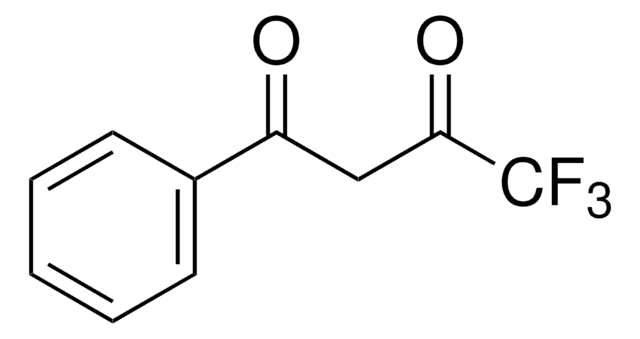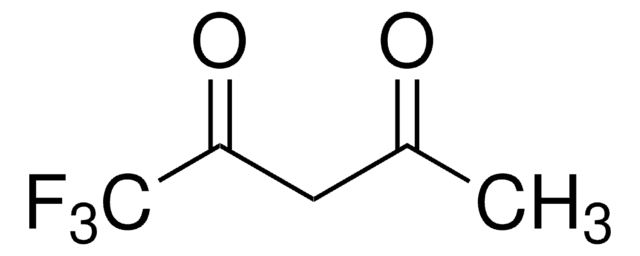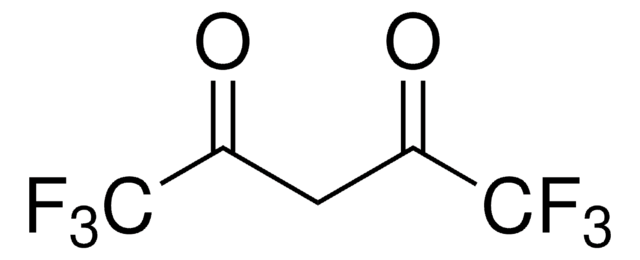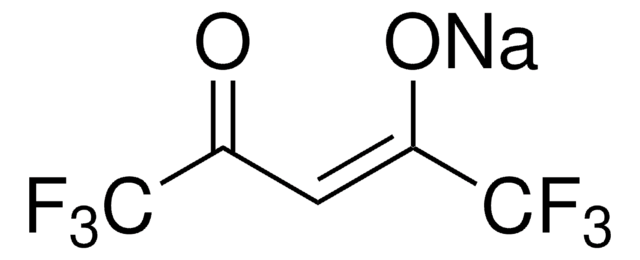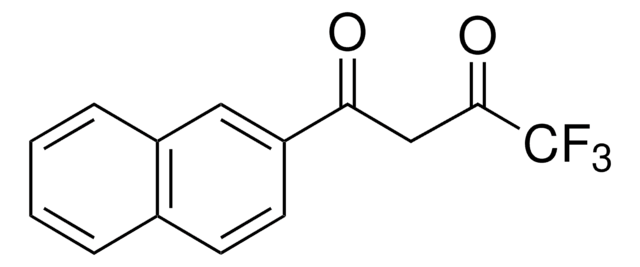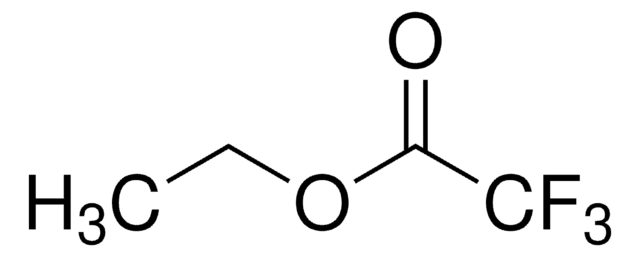Wszystkie zdjęcia(1)
Kluczowe dokumenty
469548
1,1,1-Trifluoro-5,5-dimethyl-2,4-hexanedione
98%
Synonim(y):
PTA, Pivaloyltrifluoroacetone
Zaloguj sięWyświetlanie cen organizacyjnych i kontraktowych
About This Item
Wzór liniowy:
(CH3)3CCOCH2COCF3
Numer CAS:
Masa cząsteczkowa:
196.17
Numer WE:
Numer MDL:
Kod UNSPSC:
12352100
Identyfikator substancji w PubChem:
NACRES:
NA.22
Polecane produkty
Poziom jakości
Próba
98%
współczynnik refrakcji
n20/D 1.407 (lit.)
bp
138-141 °C (lit.)
gęstość
1.129 g/mL at 25 °C (lit.)
ciąg SMILES
CC(C)(C)C(=O)CC(=O)C(F)(F)F
InChI
1S/C8H11F3O2/c1-7(2,3)5(12)4-6(13)8(9,10)11/h4H2,1-3H3
Klucz InChI
BVPKYBMUQDZTJH-UHFFFAOYSA-N
informacje o genach
mouse ... Mtap(66902)
Powiązane kategorie
Opis ogólny
1,1,1-Trifluoro-5,5-dimethyl-2,4-hexanedione (TFDMHD) is a 1,3-diketone. It forms Er(3+) complexes. These complexes shows thermally activated slow relaxation of magnetization under a zero direct-current (DC) field.
Zastosowanie
1,1,1-Trifluoro-5,5-dimethyl-2,4-hexanedione (TFDMHD) may be used in the synthesis of series of NNO ketoimines bearing trifluoromethyl substituents, via Schiff base condensation. It may be used in the synthesis of octahedral Werner-type cobalt(II) complexes. It was used in the preparation of D2-TFDMHD, by mixing with D2O.
Ta strona może zawierać tekst przetłumaczony maszynowo.
Hasło ostrzegawcze
Warning
Zwroty wskazujące rodzaj zagrożenia
Klasyfikacja zagrożeń
Flam. Liq. 3
Kod klasy składowania
3 - Flammable liquids
Klasa zagrożenia wodnego (WGK)
WGK 3
Temperatura zapłonu (°F)
105.8 °F - closed cup
Temperatura zapłonu (°C)
41 °C - closed cup
Środki ochrony indywidualnej
Eyeshields, Faceshields, Gloves, type ABEK (EN14387) respirator filter
Wybierz jedną z najnowszych wersji:
Masz już ten produkt?
Dokumenty związane z niedawno zakupionymi produktami zostały zamieszczone w Bibliotece dokumentów.
Klienci oglądali również te produkty
Conrad Helm et al.
Frontiers in zoology, 15, 36-36 (2018-10-03)
A median, segmented, annelid nerve cord has repeatedly been compared to the arthropod and vertebrate nerve cords and became the most used textbook representation of the annelid nervous system. Recent phylogenomic analyses, however, challenge the hypothesis that a subepidermal rope-ladder-like
Reza Zarenoe et al.
Journal of the American Academy of Audiology, 28(2), 141-151 (2017-02-28)
Tinnitus is a common condition and there is a need to evaluate effects of tinnitus management in relation to moderating factors such as degree of hearing loss. As it is possible that tinnitus influences concentration, and thus is likely to
J Rafael Ciges-Tomas et al.
Nature communications, 10(1), 3676-3676 (2019-08-17)
Stl is a master repressor encoded by Staphylococcus aureus pathogenicity islands (SaPIs) that maintains integration of these elements in the bacterial chromosome. After infection or induction of a resident helper phage, SaPIs are de-repressed by specific interactions of phage proteins
Xihao Pan et al.
Colloids and surfaces. B, Biointerfaces, 181, 226-233 (2019-05-31)
Fenton technology has been proven an effective way to remove dyes from wastewater. However, the demanding pH of reaction condition restricted its wide application. In this study, we report a novel Fenton-like catalyst (Fe3O4@PDA-MnO2) facilely synthesized by polydopamine (PDA) coating
Christina Vrahnas et al.
Nature communications, 10(1), 3436-3436 (2019-08-02)
Mineralized bone forms when collagen-containing osteoid accrues mineral crystals. This is initiated rapidly (primary mineralization), and continues slowly (secondary mineralization) until bone is remodeled. The interconnected osteocyte network within the bone matrix differentiates from bone-forming osteoblasts; although osteoblast differentiation requires
Nasz zespół naukowców ma doświadczenie we wszystkich obszarach badań, w tym w naukach przyrodniczych, materiałoznawstwie, syntezie chemicznej, chromatografii, analityce i wielu innych dziedzinach.
Skontaktuj się z zespołem ds. pomocy technicznej